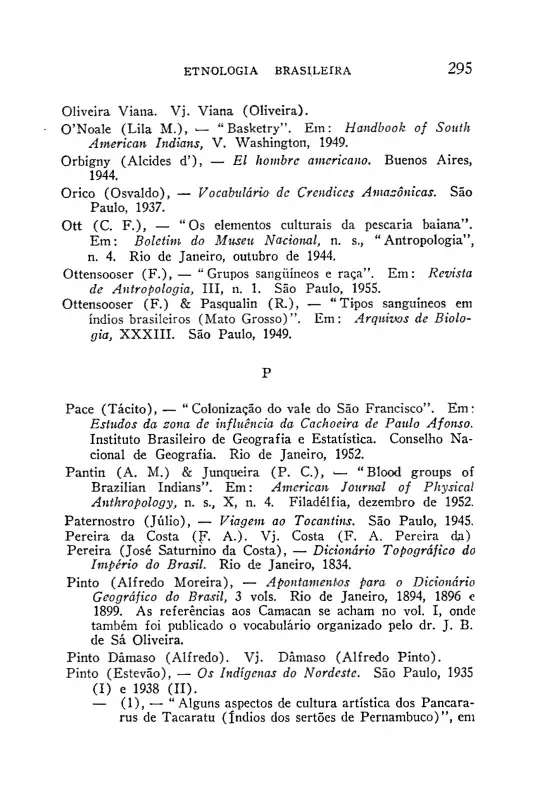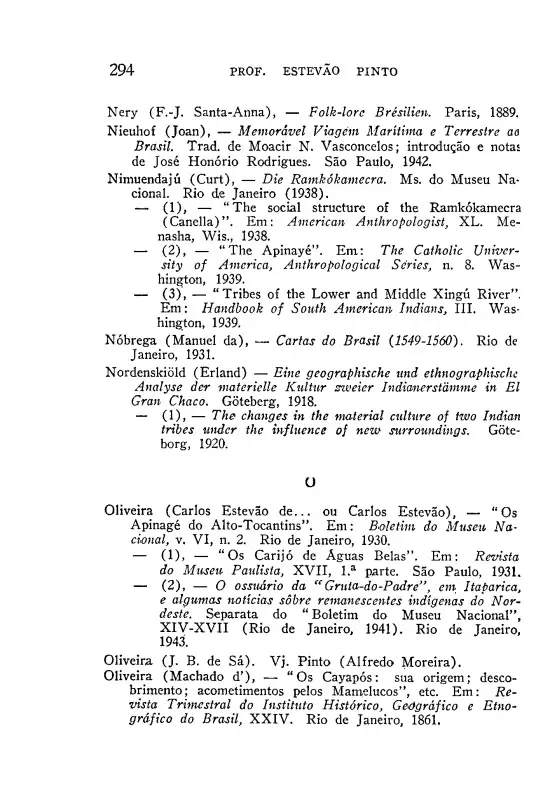Nery (F.-J. Santa-Anna), - Folk-lore Brésilien. Paris, 1889.
Nieuhof (Joan), - Memorável Viagem Marítima e Terrestre ao Brasil. Trad. de Moacir N. Vasconcelos; introdução e notas de José Honório Rodrigues. São Paulo, 1942.
Nimuendajú (Curt), - Die Ramkókamecra. Ms. do Museu Nacional. Rio de Janeiro (1938).
_____(1), - "The social structure of the Ramkókamecra (Canella)". Em: American Anthropologist, XL. Menasha, Wis., 1938.
_____(2), - "The Apinajé". Em: The Catholic University of America, Anthropological Séries, n.º 8. Washington, 1939.
_____(3), - "Tribes of the Lower and Middle Xingú River", Em: Handbook of South American Indians, III. Washington, 1939.
N6brega. (Manuel da), - Cartas do Brasil (1549-1560). Rio de Janeiro, 1931.
Nordenskiöld (Erland) - Eine geographische und ethnographische Analyse der materielle Kultur zweier Indianerstämme in El Gran Chaco. Göteberg, 1918.
_____(1), - The changes in the material culture of two Indian tribes under the influence of new surroundings. Göteborg, 1920.
O
Oliveira (Carlos Estevão de... ou Carlos Estevão), - "Os Apinagé do Alto Tocantins". Em: Boletim do Museu Nacional, v. VI, n. 2. Rio de Janeiro, 1930.
_____(1), - "Os Carijó de Águas Belas". Em: Revista do Museu Paulista, XVII, 1.{ parte. São Paulo, 1931.
_____(2), - O ossuário da "Gruta do Padre", em Itaparica, e algumas notícias sobre remanescentes indígenas do Nordeste. Separata do "Boletim do Museu Nacional", XIV-XVII (Rio de Janeiro, 1941). Rio de Janeiro, 1943.
Oliveira, (J. B. de Sá). Vj. Pinto (Alfredo Moreira).
Oliveira (Machado d'), - "Os Cayapós: sua origem; descobrimento; acometimentos pelos Mamelucos", etc. Em: Revista Trimestral do Instituto Histórico, Geográfico e Etnográfico do Brasil, XXIV. Rio de Janeiro, 1861.


